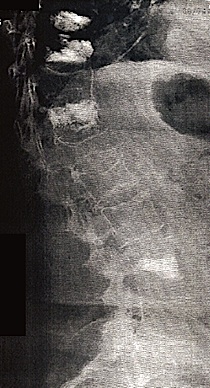
I rarely recommend vertebroplasty or kyphoplasty, but am describing it here because it is a common procedure. The most recent studies suggest it does not help in the long run.
Vertebroplasty is a procedure done on recent painful vertebral compression fractures. A needle is inserted into the vertebral body, and liquid plastic cement (usually methacrylate) is injected. This solidifies inside the vertebra. The procedure frequently reduces back pain. Kyphoplasty is similar, except first a balloon is inserted into the vertebral body and inflated. Then the cement is injected into the space. More cement is used during kyphoplasty, but it is inserted under a lower pressure. It is more expensive than vertebroplasty and requires general anesthesia.
These procedures do not cure the osteoporosis. In fact, the cement is harder than the natural bone, and can act like a hammer on the neighboring vertebrae and cause them to fracture. It is important to treat the underlying osteoporosis, but this is not always done. Even in some of the studies, a substantial number of subjects did not receive medicines for their osteoporosis.
Uncontrolled studies have suggested that these procedures are safe and effective, but recently several papers have been published which challenge this view:
A randomized, unblinded trial of kyphoplasty vs. no kyphoplasty was done in 300 subjects with acute vertebral fractures (Wardlaw D). After one month, the quality of life had improved more in the kyphoplasty group. At 6 months the scores were slightly better in the kyphoplasty group, and by one year there was no difference in quality of life between those who had received kyphoplasty and those who did not. There were no myocardial infarctions or pulmonary emboli within the first month in the kyphoplasty group, but cement did leak out of the vertebrae 27% of the time. 80% of patients received osteoporosis treatments during the next year. During that year, there were new vertebral fractures in 33% of the patients in the kyphoplasty group and 25% of the patients in the control group (not a significant difference).
A randomized, unblinded trial of vertebroplasty vs. conservative treatment in 50 patients (Rousing R) found that recovery from pain was similar with our without vertebroplasty. subjects were observed for 3 months. There were 2 adjacent fractures in the vertebroplasty group and non in the controls.
A randomized trial compared effects of vertebroplasty vs. kyphoplasty in 100 patients (Liu JT) and found no difference in symptoms between the groups after 6 months. There was a greater post-operative increase in the vertebral body height in the kyphoplasty group. Two patients in the kyphoplasty group had adjacent vertebral fractures.
A non-randomized prospective comparing these two procedures enrolled 60 patients, and again no difference in pain was seen between vertebroplasty and kyphoplasty (Schofer MD). Only one adjacent vertebral fracture was seen, and that was in a patient who had the kyphoplasty.
Two randomized, blinded trials of vertebroplasty were published side-by-side in the New England Journal of Medicine. The patients with painful vertebral fractures were randomized to a sham operation or a vertebroplasty. In the study by (Buchbinder R), there were 78 subjects, and there were no differences in pain or quality of life at any time point. By 6 months there were new vertebral fractures in 3 patients with vertebroplasty and 4 with sham operation. Similar findings were reported by (Kallmes DF), in a study of 131 patients. At 1 month there was no significant difference in the pain or quality of life scores, and at 3 months there were more subjects in the control group who crossed over to the other group. The rate of new vertebral fractures was not reported.
A meta-analysis of complications (Lee MJ) from 121 reports, including 29 prospective reports, found that vertebroplasty had a higher rate of complications, new vertebral fractures, and cement linkage compared to kyphoplasty. However, these differences were not noted in the prospective studies.
|
A retrospective study of 852 patients who had received vertebroplasty found that 141 of them (16%) had a new vertebral compression fracture (Tseng YY). Of these, 64% were adjacent to a vertebra that had the procedure. These adjacent fractures also happened an average of 71 days after the procedure, whereas non-adjacent fractures occurred 286 days later.
A systematic review of the literature found the risk of a pulmonary embolism ranged from 3.5 to 23% (Krueger A). The higher rates were found when the investigators routinely did X-rays of the lungs after the procedures.

